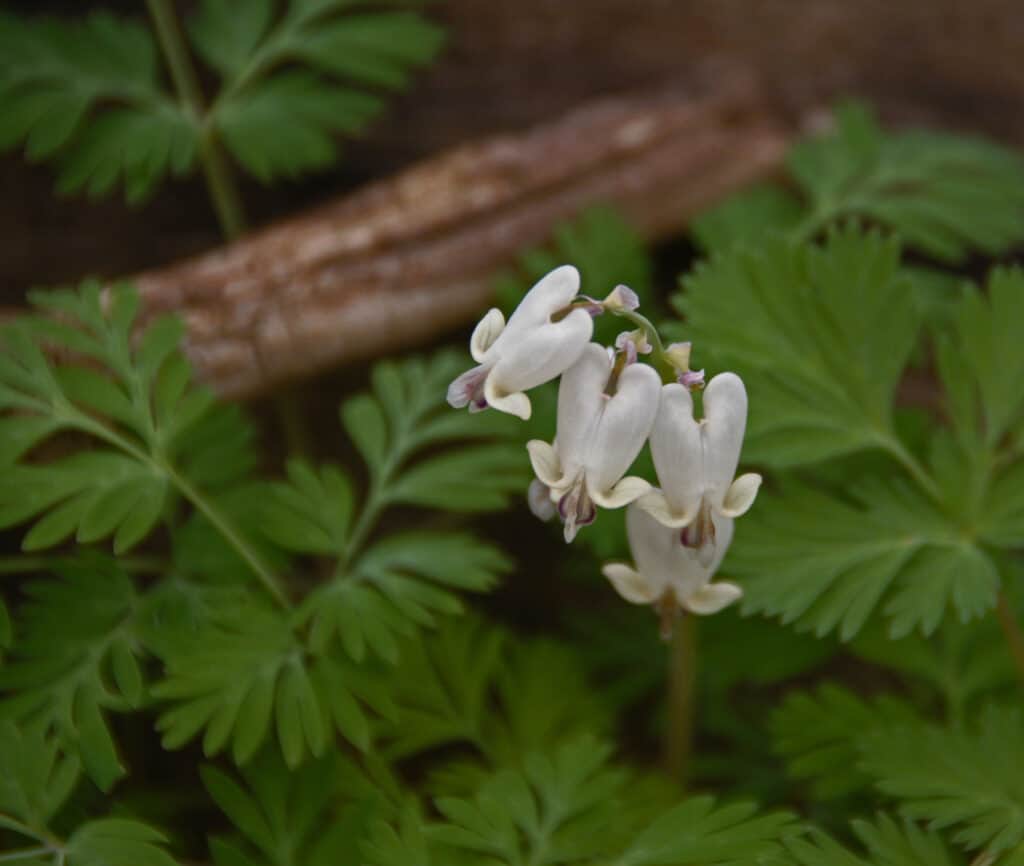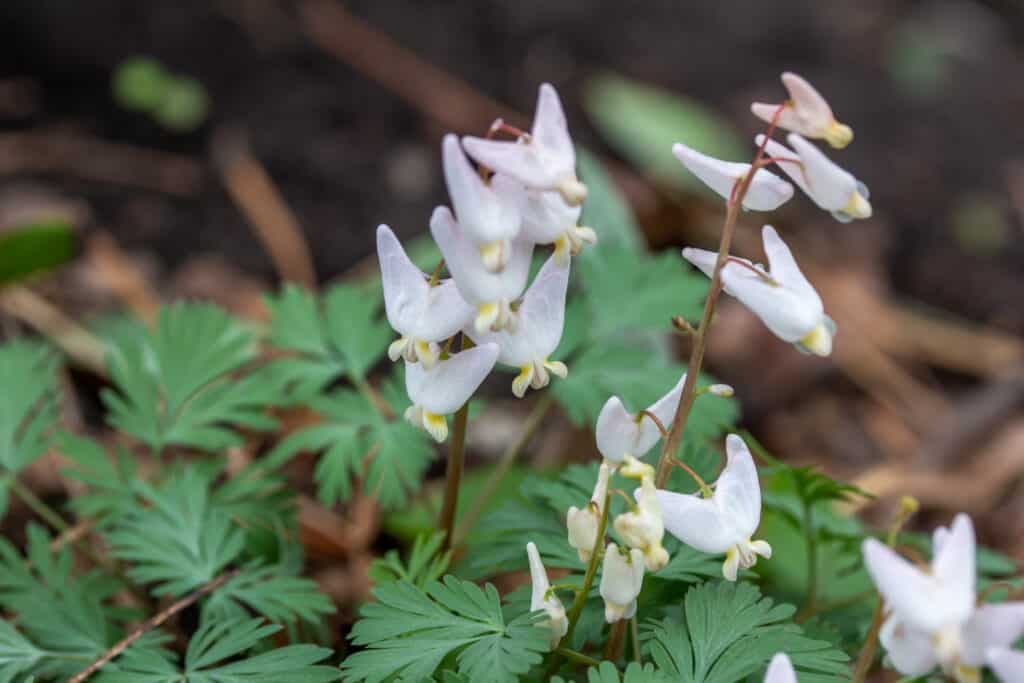If you enjoy forest-loving plants with unique flowers, you may be familiar with the plants in the Dicentras genus. Two species in this genus, squirrel corn and Dutchman’s breeches, adorn fertile, moist hardwood forests across Eastern North America.
While distinguishing these stunning little plants can be difficult, especially when they’re not flowering, the plants do have their own unique distinguishing features. In this guide, we’ll compare squirrel corn vs. Dutchman’s breeches, discussing their plant classifications, physical characteristics, native ranges and ideal growing conditions, and ecological niches. Read on to learn more!
Squirrel Corn vs. Dutchman’s Breeches: A Quick Look
| Squirrel Corn | Dutchman’s Breeches | |
|---|---|---|
| Plant Classification | Dicentra canadensis | Dicentra cucullaria |
| Physical Characteristics | Herbaceous, perennial wildflower that grows 6-12 inches tall. Leaves are compound and leaflets are finely divided into sharply cut, narrow segments. The leaves grow basally. Flowers are elongated heart-shaped and all white. They are flared out at the bottom with a revealed stigma. 4-8 Flowers grow in a cluster along an upright raceme. Roots contain small yellow nodes. | Herbaceous, perennial wildflower that grows 10-12 inches tall. The leaves are compound and leaflets are finely divided into sharply cut, narrow segments. The leaves grow basally. 3-8 flowers grow along an upright-slightly arched bare raceme. |
| Native Ranges and Ideal Growing Conditions | Native to parts of Central and Eastern North America hardwood forests. Prefers shade to partial-shade and grows in fertile forests and rocky outcrops. Prefers to grow in neutral-acidic, consistently moist, humus-rich soil. | Native to rich hardwoods of Eastern North America and in small populations in the US Pacific Northwest. Grows in humus-rich or rocky forests, ravines, and outcrops. Prefers moist, slightly acidic-neutral loamy soil but can also tolerate clay soils. Grows in shade to partial shade. |
| Ecological Niches | Squirrels feed on the underground nodes in the Fall. Pollinated by queen bumble bees. Robber bees feed on nectar. Ants disperse seeds. | Pollinated by Eastern North American bumble bees. Seed dispersal by ants. |
Plant Classification
While both squirrel corn and Dutchman’s breeches belong to the Dicentras genus, they are members of separate species. Squirrel corn, Dicentras canadensis, and Dutchman’s breeches, Dicentras cucullaria, are two of eight species within the Dicentras genus. Both plants belong to the poppy, or Papaveraceae, family.

Squirrel corn (
Dicentra canadensis) flowers are elongated heart-shaped and all white.
©iStock.com/Gingerjohns
Squirrel Corn vs. Dutchman’s Breeches: Plant Characteristics
When squirrel corn and Dutchman’s breeches aren’t flowering, distinguishing between these two unique plants can be quite difficult.
Both are herbaceous flowering perennial plants that can grow up to 12 inches tall at maturity. They both have deeply divided, compound, feathery, and blue-green leaves that grow basally along the ground. The basal growth pattern of leaves means that the leaves tend to remain around the base of the plant’s stalk. Without uprooting the plants, the best way to distinguish non-flowering squirrel corn and Dutchman’s breeches is to closely look at the leaves. While both plants have strikingly similar leaves, it’s important to note that the leaves of squirrel corn are a shade more blue-green in color and more finely divided than Dutchman’s breeches.
Once these plants are flowering, it’s much easier to differentiate squirrel corn vs. Dutchman’s breeches. At first glance, the flowers of these plants may look similar, but each has distinct physical characteristics. Notably, squirrel corn’s flowers have an elongated heart shape while Dutchman’s breeches resemble upside-down puffy pantaloons.
In botanical terms, the flowers of squirrel corn differ from Dutchman’s breeches mainly by the shape of the petal spurs. Petal spurs are tubular outgrowths of a flower filled with nectar that attracts pollinators. For squirrel corn, the petal spurs located at the top of the flower are rounded and converge toward each other. The shape of these petal spurs contributes to the heart shape of the flower. Conversely, the petal spurs of Dutchman’s breeches, also located at the top of the flower, spread notably further apart from each other and have tapered ends.
Additionally, the flowers of squirrel corn tend to be all white while the flowers of Dutchman’s breeches have a yellow tinge to the two bottom flared petals.

The flowers of Dutchman’s breeches (
Dicentra cucullaria) spread notably further apart from each other and have tapered ends.
©iStock.com/Cynthia Shirk
Native Ranges and Ideal Growing Conditions
The native ranges of squirrel corn and Dutchman’s breeches have a large overlapping region in the hardwood forests of Eastern North America. However, squirrel corn can be found in moist, fertile forests of Central US, while small populations of Dutchman’s breeches grow in pockets of the US Pacific Northwest.
Both of these plants prefer to grow in shade to partial shade, and fertile, moist, soil with a slightly acidic to neutral pH. Both can grow in fertile forests, rocky outcrops, and moist ravines. In fact, hikers can often find squirrel corn and Dutchman’s breeches growing in the same area.
As Spring ephemerals, both of these plants emerge, flower, go to seed, and die back in the Spring. Dutchman’s breeches thrive in USDA Hardiness Zones 3a-7a while squirrel corn can thrive in USDA Hardiness Zones 4a-7b.

The structures of both plants’ flowers are best suited for pollination by bumble bees.
©NatureServe / Flickr – License
Squirrel Corn vs. Dutchman’s Breeches: Ecological Niches
Regarding their ecological niches, both squirrel corn and Dutchman’s breeches attract specific pollinators and seed dispersers. The structures of both plants’ flowers are best suited for pollination by bumble bees. Specifically, Eastern North American bumble bees are perfectly adapted for pollinating the flowers as the bees can separate the outer and inner petal layers.
As its common name suggests, squirrel corn is known to attract squirrels, which unearth and feed upon the yellow nodes that grow from the roots of the plant. Unlike squirrel corn, Dutchman’s breeches do not contain these nodes attached to their roots.
In terms of seed dispersal methods, both plants benefit from seed dispersal via ants. The plants produce an additional structure on the exterior of seeds, called an elaiosome. A fatty oil comprises the elaiosome which attracts ants. The ants collect the seeds of these unique plants, carry them to their nests, feed upon the elaiosome, and discard the unharmed seeds outside of their nests, where they germinate. Ants also drop some seeds along the way to the nest, resulting in another method of seed dispersal by ants.
Up Next
- Dutchman’s Breeches vs. Bleeding Heart: What Are The Differences?
- 5 Perennial Flowers For Shade
- Crispy Wave Fern vs Bird’s Nest Fern
The photo featured at the top of this post is © Malachi Jacobs/Shutterstock.com
Sources
- Adirondacks Forever Wild, Available here: https://www.wildadirondacks.org/adirondack-wildflowers-dutchmans-breeches-dicentra-cucullaria.html
- NC State Extension, Available here: https://plants.ces.ncsu.edu/plants/dicentra-canadensis/
- NC State Extension, Available here: https://plants.ces.ncsu.edu/plants/dicentra-cucullaria/
Thank you for reading! Have some feedback for us? Contact the AZ Animals editorial team.






